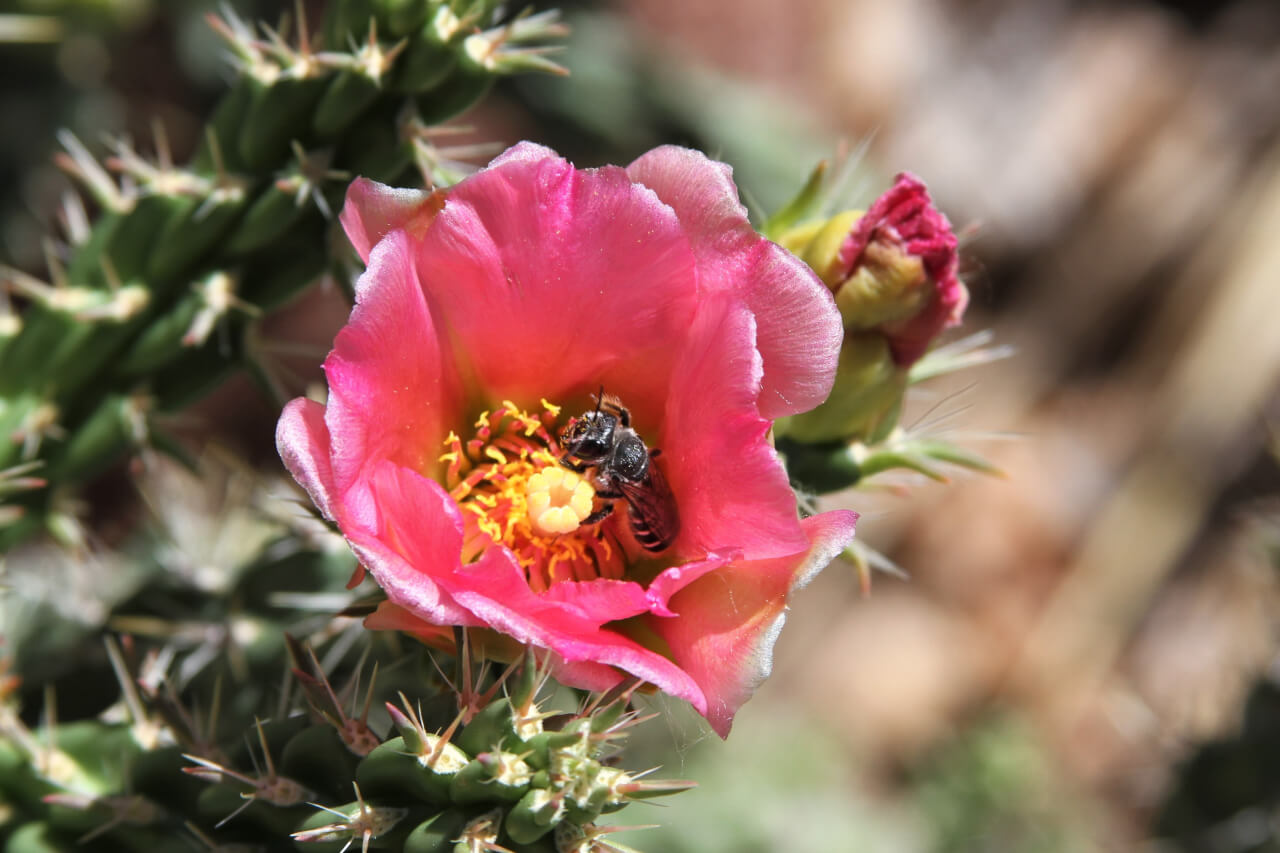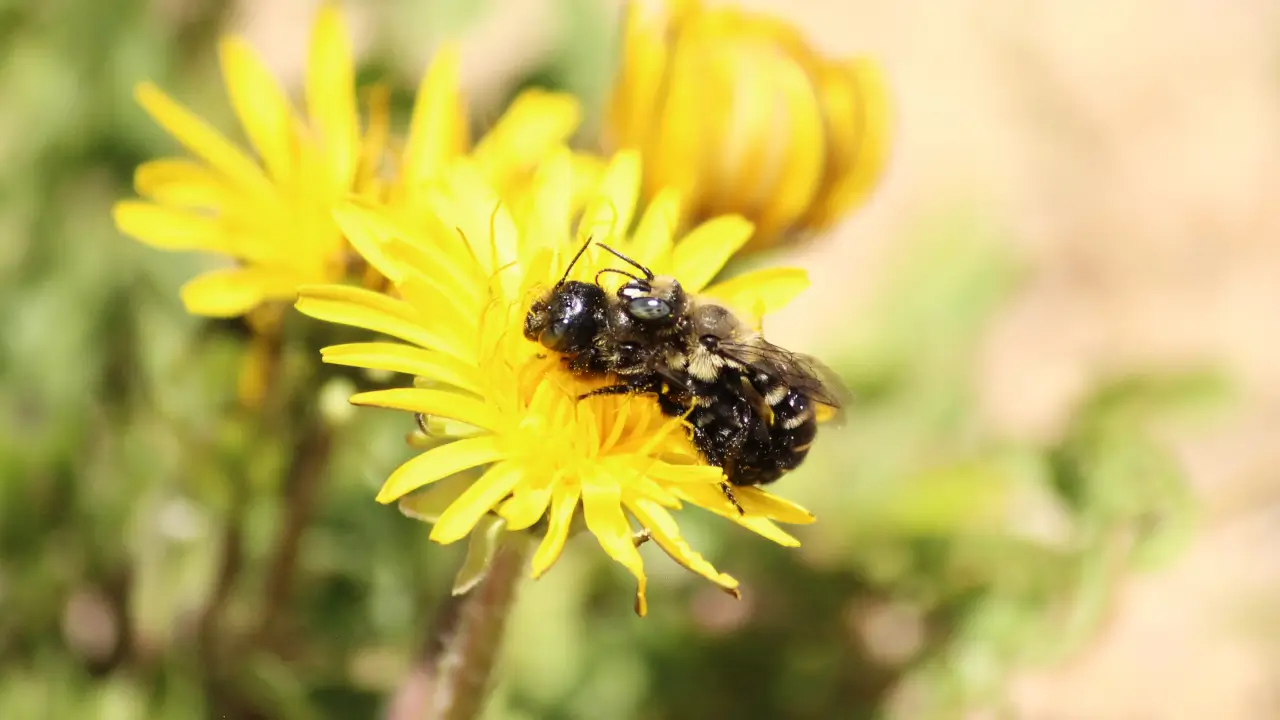Meet the Woman Who Launched a Local Training Program to Save Native Bees
Andrea Montoya created an advocacy program of community members to plant native species across the city, re-wilding urban spaces into critical habitat.
Meet the Woman Who Launched a Local Training Program to Save Native Bees
Andrea Montoya created an advocacy program of community members to plant native species across the city, re-wilding urban spaces into critical habitat.

Andrea Montoya is on a mission to save native bees.submitted.
In Boulder, Colorado, the grasses and prairie flowers of the Great Plains wave as they stretch up, eventually giving way to the Ponderosa pines that dot the Rocky Mountains. This ecosystem overlap is why, of the 946 species of bees native to Colorado, 562 of them can be found in Boulder County. Andrea Montoya is on a mission to learn from this natural ecosystem overlap and rewild urban spaces with native plants. In doing so, she hopes to ensure this unique population of pollinators can thrive for generations to come.
Three years ago, Montoya started the Pollinator Advocates program. In that short time, she’s trained nearly 50 community members in-depth about the importance of native habitat for pollinators and reintroduced thousands of native plants to yards and parks around Boulder.
“I am positive that [this led to] an empiric increase in the numbers of insects and hummingbirds in our neighborhoods,” she says. “We are currently working with entomologists on setting up surveys across the city.”
Montoya spent decades improving the well-being of people as a physician’s assistant, treating cancer and auto-immune diseases and supporting patient recovery with herbal remedies. But since retiring in 2015, she’s become dedicated to improving the well-being of “our Great Mother.”
She first stumbled across a native bee house at the library in 2018 on a walk with her grandson. This prompted a research deep dive, learning from local experts and taking courses at the University of Colorado, and spiraled into community activism.
“The more I read about these native bees and plants and ecosystems, the more I realized that the reason why pollinators were so in decline is because they lost habitat,” says Montoya. She looked around her own neighborhood—densely packed with houses and “dead sod.” An ecological graveyard.

Native pollinators need the relationships they have with native plant species to survive, like how monarch caterpillars only eat milkweed. We love songbirds, but they need healthy insect populations to thrive. Montoya points out that a pair of chickadees need 6,000 to 9,000 caterpillars to raise a clutch of young before they leave the nest.
In 2019, Montoya started out by giving native plants (donated by Harlequin’s Gardens and Growing Gardens) to neighbors to encourage buy-in. She recruited volunteers to plant in “pocket parks,” small public spaces in densely populated neighborhoods, and would pass along what she’d learned about pollinators. Her Polish and Mexican Indigenous heritage helps her connect with people from diverse backgrounds, building a network of interested community members.
TAKE ACTION
How to create a pollinator garden in your yard.
The city-sponsored free Pollinator Advocates (PA) program she launched in 2021 is now “bigger than I could have imagined,” she says. “Time and again, it really keeps me going that so many people are drawn to the work.” The PA program is application-based and open to adults within Boulder, with 20 people per cohort. Organizers try to choose applicants with a mix of backgrounds and experience, to ensure diversity within the group.
Participants commit to attending a weekly two-hour lecture from June through August with local experts—including professors, researchers and conservationists—who teach about native pollinators and plants, and they spend roughly 15 hours volunteering to plant and maintain pollinator habitat in the city. In the end, graduating PAs receive $150 worth of native plants for their own yards from Harlequin’s Gardens.
Montoya’s favorite moments are when she’s out with a group of new PAs or volunteers and a bee lands on a flower. In her experience, it’s like watching a baby being born.
“You’re gonna think I’m exaggerating,” her face is lit up, joyful, “but everyone goes ‘Ah! Look! It’s a bee! It’s here! It’s working!’ So, there’s little tiny miracles that I never thought I’d get to witness happening over and over again.”
But not everything is miraculous. One of Monotoya’s biggest challenges is that people have major fears of insects. Even nature documentaries “show insects as being these weird, aggressive, pinchy, bitey monsters.” When going into communities to talk about pollinators, she starts with the less anxiety-inducing species: butterflies and hummingbirds. If the conversation is going well, she’ll pull up a picture of a native bee—from the millimeter-long Perdita minima to metallic green sweat bees or a lumbering bumble bee. Seeing these insects in less frightening ways can open people’s minds to the benefits and beauty of native pollinators.
Montoya sees her work as climate action and a way to bring life and biodiversity back to our environment. “It’s a chance to right a wrong as humans,” she explains.

So, what can we all do to support native pollinators, especially farmers? Talk to your neighbors and advocate for pollinators, plus take these three actions.
First, stop using chemical pesticides. “You’ll kill the very organisms both in the soil and flying around that you need,” says Montoya. She says that commercial pesticides contain toxins harmful to humans as well. She encourages people to opt for natural pest management options, such as creating a healthy ecosystem or killing invasive pests such as Japanese beetles by knocking them into a bucket of soapy water. For Montoya, the best pest management technique is creating a native habitat, as there are more beneficial insects that can prey on and outcompete harmful ones.
Second, plant regionally native plants around your garden or farm, being sure to have blooms across as much of the season as possible. “Plants that need the native soil don’t really need all the nutrients in a food garden bed,” she says, so she recommends 100 feet to 300 feet between your veggie beds and native plants so they all thrive.
Third, leave some patches of bare soil—no mulch, no thick cover crop, no plastic—as the majority of native bee species nest in the ground.
Follow us
This work is licensed under a Creative Commons Attribution-NoDerivatives 4.0 International License.
Want to republish a Modern Farmer story?
We are happy for Modern Farmer stories to be shared, and encourage you to republish our articles for your audience. When doing so, we ask that you follow these guidelines:
Please credit us and our writers
For the author byline, please use “Author Name, Modern Farmer.” At the top of our stories, if on the web, please include this text and link: “This story was originally published by Modern Farmer.”
Please make sure to include a link back to either our home page or the article URL.
At the bottom of the story, please include the following text:
“Modern Farmer is a nonprofit initiative dedicated to raising awareness and catalyzing action at the intersection of food, agriculture, and society. Read more at <link>Modern Farmer</link>.”
Use our widget
We’d like to be able to track our stories, so we ask that if you republish our content, you do so using our widget (located on the left hand side of the article). The HTML code has a built-in tracker that tells us the data and domain where the story was published, as well as view counts.
Check the image requirements
It’s your responsibility to confirm you're licensed to republish images in our articles. Some images, such as those from commercial providers, don't allow their images to be republished without permission or payment. Copyright terms are generally listed in the image caption and attribution. You are welcome to omit our images or substitute with your own. Charts and interactive graphics follow the same rules.
Don’t change too much. Or, ask us first.
Articles must be republished in their entirety. It’s okay to change references to time (“today” to “yesterday”) or location (“Iowa City, IA” to “here”). But please keep everything else the same.
If you feel strongly that a more material edit needs to be made, get in touch with us at [email protected]. We’re happy to discuss it with the original author, but we must have prior approval for changes before publication.
Special cases
Extracts. You may run the first few lines or paragraphs of the article and then say: “Read the full article at Modern Farmer” with a link back to the original article.
Quotes. You may quote authors provided you include a link back to the article URL.
Translations. These require writer approval. To inquire about translation of a Modern Farmer article, contact us at [email protected]
Signed consent / copyright release forms. These are not required, provided you are following these guidelines.
Print. Articles can be republished in print under these same rules, with the exception that you do not need to include the links.
Tag us
When sharing the story on social media, please tag us using the following: - Twitter (@ModFarm) - Facebook (@ModernFarmerMedia) - Instagram (@modfarm)
Use our content respectfully
Modern Farmer is a nonprofit and as such we share our content for free and in good faith in order to reach new audiences. Respectfully,
No selling ads against our stories. It’s okay to put our stories on pages with ads.
Don’t republish our material wholesale, or automatically; you need to select stories to be republished individually.
You have no rights to sell, license, syndicate, or otherwise represent yourself as the authorized owner of our material to any third parties. This means that you cannot actively publish or submit our work for syndication to third party platforms or apps like Apple News or Google News. We understand that publishers cannot fully control when certain third parties automatically summarize or crawl content from publishers’ own sites.
Keep in touch
We want to hear from you if you love Modern Farmer content, have a collaboration idea, or anything else to share. As a nonprofit outlet, we work in service of our community and are always open to comments, feedback, and ideas. Contact us at [email protected].by Lindsey Beatrice, Modern Farmer
April 5, 2024
Modern Farmer Weekly
Solutions Hub
Innovations, ideas and inspiration. Actionable solutions for a resilient food system.
ExploreExplore other topics
Share With Us
We want to hear from Modern Farmer readers who have thoughtful commentary, actionable solutions, or helpful ideas to share.
SubmitNecessary cookies are absolutely essential for the website to function properly. This category only includes cookies that ensures basic functionalities and security features of the website. These cookies do not store any personal information.
Any cookies that may not be particularly necessary for the website to function and are used specifically to collect user personal data via analytics, ads, other embedded contents are termed as non-necessary cookies.
Doors having only a single hive or so help the entire program ? Had 4 hives some years ago.
Had 4 hives on parents ranch years ago – interesting as to can I help and in what ways
This is such a beautiful program that Andrea has created! I love bees and without them we would all perish. They are literally life bringers. Bravo Andrea! You make the difference. Thank you!